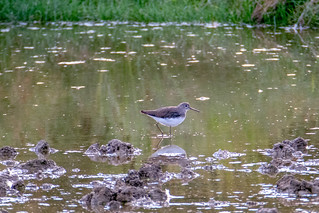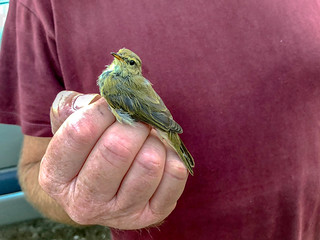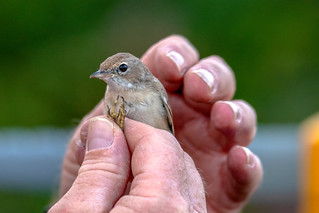The August meeting of the Banbury Ornithological Society (BOS) was an outdoor meeting at Bicester Wetland Reserve; the entrance to the reserve is immediately past the Bicester Avenue retail park/garden centre on the edge of Bicester.
Bicester Wetland Reserve is managed by the BOS on behalf of Thames Water. This is a member-only site due to the hazardous nature of heavy moving equipment and hazardous areas. The site can be locked at any time by Thames Water, therefore keys are vital.
The reserve manager Alan Peters gave an introductory talk about the site and about viewing from three hides. Created in 1999, Bicester Wetland Reserve was the result of an agreement between the BOS and Thames Water. The 7 hectare site was previously used for the disposal of sewage sludge from the nearby sewage treatment works. Channels and scrapes were excavated with supporting bunds and water control mechanisms.
 We split into groups as it wouldn't be possible for us all to visit the hides at the same time. David Tustian was with me and we chose to start at the far end of the reserve at the new hide by the railway. Here there is a small pool of water who's fringes are churned up into mud by grazing cattle. We entered the hide and were pleased to see a handful of green sandpiper [#134] - new for the year. These birds move between the main scrape and this pool and as we watched most did so, with others returning. Three snipe fed in the shallows and a couple of grey heron stood watch.
We split into groups as it wouldn't be possible for us all to visit the hides at the same time. David Tustian was with me and we chose to start at the far end of the reserve at the new hide by the railway. Here there is a small pool of water who's fringes are churned up into mud by grazing cattle. We entered the hide and were pleased to see a handful of green sandpiper [#134] - new for the year. These birds move between the main scrape and this pool and as we watched most did so, with others returning. Three snipe fed in the shallows and a couple of grey heron stood watch.
As we walked back we stopped at the middle hide. From here we could look back and see various wildfowl and a couple of little egrets.  A family of magpies made noisy conversation and four buzzard quartered the other side of the railway tracks.
A family of magpies made noisy conversation and four buzzard quartered the other side of the railway tracks.
As we set off back to the main hide we talked with Jo and Chris Morgan and found out that they had seen some bird ringing - a juvenile blue tit. Colin Wearn (who conducts ringing on the site) had his mist nets in place for a ringing demonstration. We got back and luckily they were just setting off to collect any other birds caught in the nets - this time a juvenile chiffchaff.
Watching from the hide a group spotted a water rail [#135] skulking in the far fringes across the water - soon lost heading right and behind reeds.
 Another visit to the nets yielded two more birds: another chiffchaff and a common whitethroat. I had a chat to Colin and he told me about his visits to Ascension Island to survey and study the sooty terns - he also showed me some photos and video on his camera. We also talked about his ringing demonstrations at Countryfile Live at Blenheim the previous week - he also had great photos of elephant hawk moth caterpillars in standard brown, but also green livery.
Another visit to the nets yielded two more birds: another chiffchaff and a common whitethroat. I had a chat to Colin and he told me about his visits to Ascension Island to survey and study the sooty terns - he also showed me some photos and video on his camera. We also talked about his ringing demonstrations at Countryfile Live at Blenheim the previous week - he also had great photos of elephant hawk moth caterpillars in standard brown, but also green livery.
As we prepared to leave, the house martins that were skating cross the pools were first joined by a few swallows and then up to 9 swifts. No sooner had we started to talk about the swifts that a cloud of swallows descended and filled the sky. They then skimmed the pools and provided a spectacular sight.
A great visit and hopefully I can get back at the right time to catch up with the water rail in the winter.
Sightings (25) included: black-headed gull, blackbird, buzzard, canada goose, carrion crow, chiffchaff, coot, gadwall, green sandpiper, grey heron, house martin, little egret, magpie, mallard, moorhen, pied wagtail, rook, snipe, swallow, swift, teal, tufted duck, water rail, whitethroat and woodpigeon.

No comments:
Post a Comment